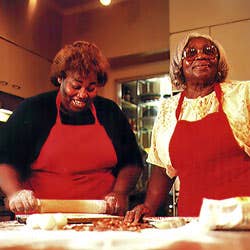
Mama Lou’s Thanksgiving
Anne Scott Coleman, a large and graceful woman, moves across the kitchen floor with almost balletic concentration. The room is filled with the innardy scent of giblets simmering with sage and celery. Corn bread—field-sweetness itself—warms in the oven, while yeast rolls rise in the pantry, butter-fragrant and barmy. Sweet potato pies and pecan pies honey the air with cinnamon, while languid oysters hang suspended in their bath, awaiting Coleman's skillful ministrations. A turkey, flecked with butter, looks like a naked guest at the party. We are in the very maw of food.
Coleman, a Memphis cook and caterer, makes Thanksgiving dinner not from recipes but from deep personal memory. She tells me how, as she restlessly chops onions and minces parsley: "My father was the maitre d' at the Memphis Country Club," she says, "so we grew up around food and cooking. There are eight of us—three boys and five girls—and we always had Thanksgiving dinner at our grandmother's house. Her name was LouElla Hill, but everybody called her Mama Lou. She was a wonderful cook. I used to watch her in the kitchen, throwing in a little of this and a little of that. I guess I learned it all from her. Now I'm a throw-it-in cook, too. I never measure."
She continues: "For Thanksgiving, everyone just wants the taste of tradition. If we served something different, the family just wouldn't eat it." She turns to her mother, Millie Scott, who is with her in the kitchen. "It's the truth," she says, "isn't it, Mama?" Scott nods, and the two women laugh—as if sharing a joke at the expense of change.
Scott recalls that Mama Lou was the font from which all this good food sprang. "She was not a cateress," Scott explains shyly, "but she could have been, because there were always people coming by her house for food. She made all her cakes by hand. We didn't have mixers in those days, and she had a special little bowl that she used to beat the frosting in with a fork."
Coleman's strong hands knead pie dough with confident, take-charge gestures. Next, she asks her brother Wesley, who works with her, to peel the sweet potatoes for the candied yam casserole—an indispensable side dish.
Then Coleman picks up a well-used rolling pin and her hands move over it as she begins to crush crackers for the scalloped oysters she always makes as a Thanksgiving first course. "After I get the crackers ready," Coleman continues, "I'm going to melt the butter, and then I'll layer the shucked oysters with crackers and the melted butter and pour cream over them. That's the way we always do it."
As Coleman continues working, we talk about the persistence of tradition in an inconstant world, and I ask her if there is any part of her holiday meal that has been modernized over the years. She answers firmly in the negative: "We still make the pies and cakes the same way that we always have. My mother still makes the yeast rolls with sugar, and her pound cake and coconut cake, and they just have that special taste because they have not changed.
"The cranberry mold is the same one that we do every year, too, and the ambrosia is exactly the way my grandmother made it, with orange slices, grated coconut, maraschino cherries and walnuts, and tiny marshmallows on top."
Well, Coleman admits, there has been one slight change, in the way she cooks her turkey. "These days, we usually roast it in a clay pot. But today I'm going to show you the way Mama Lou used to do it, in a plain brown grocery sack." She picks up one such sack to demonstrate: "There's nothing to it. You just rub the inside of the sack with butter, then rub garlic and the other seasonings inside the turkey and add vegetables and chicken broth." During the holidays, she continues, she prepares as many as 100 turkeys for customers. "We cook so many that we call them 'flying turkeys'. They just fly out of the house. Everybody wants one, so we cook nonstop."
And when they're finished cooking, they sit down to dinner themselves: "You'd think, after making all that food, that we would want something different—but we really don't. We want everything just the way it's always been."
Like much good food, the dishes Coleman and her family make are simple; they require no sophisticated culinary technique or rare ingredients. Their presentation is unceremonious. This is food hallmarked by a sort of rococo minimalism—at once rich and simple, complex and chaste. Its flavor comes as much from memory as from seasoning. And one can sense that, though Mama Lou has been gone for many years, her spirit is right there in the kitchen with them.
Keep Reading
Continue to Next Story










